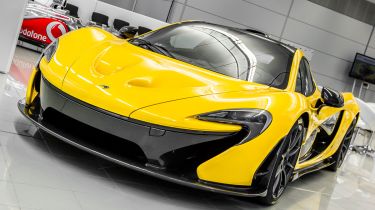McLaren P1: Full details
We get the inside line on the all-new £866,000 McLaren P1 supercar, ahead of first deliveries this summer
The McLaren P1 was the most talked about car at the Geneva Motor Show, but now we’ve been to the McLaren Technology Centre to get under the P1's carbon fibre skin.
Without body panels, it’s amazing how tightly packed the P1’s engine bay is - just like an F1 car. P1 designer Paul Howse calls it ‘shrink-wrapped design,’ and told us that as well as being inspired by McLaren’s F1 heritage – particularly the 2008 championship-winning car – and honed in the wind tunnel, the design uses biomimickery, borrowing lines from hammerhead sharks and peregrine falcons, too.
The close-fitting bodywork means lots of heat to dissipate, which is why the heat shield behind the rear window and the exhaust finisher are made from titanium, while the rear section of the exhaust is plated with gold. Although it looks complex, the carbon fibre bodywork integrates over 200 components into just three main pieces.
P1 chief designer Dan Parry-Williams tells us that the firm evaluated two and four-wheel drive, V10 and V12 engines before deciding that its existing 3.8-litre twin-turbo engine would best meet performance and sub-200g/km of CO2 emissions targets. However, right from conception in late 2009, the firm also decided to opt for hybrid technology, including a full EV mode, which has meant that 90 per cent of the engine is new.
The hybrid system adds 190kg, but McLaren reckons it’s worth it for the performance gain. The electric motor drives the gearbox at all times, cutting the effect of turbo lag and giving an extra 180bhp and 260Nm of torque. The batteries are the densest and the motor the most powerful of any fitted to a production car. To test the system, an all-electric 12C was built, and has racked up over 60,000 road miles since 2010.
To ensure that the P1 hits the right emotional note, the car’s sound has been tuned. Two sensors, one in the intake and one in the exhaust, combine to feed sound through a symposer and into the cabin behind the driver’s head. The sound is different in all four modes, including the all-electric setting.
McLaren has confirmed that 250 of the planned production run of 375 McLaren P1 supercars have been sold, with 500 hot prospects for the remaining models.
Each car costs £866,000, all are left-hand drive, and will be built at the rate of one per day from 8 July by a team of 70 technicians. Each buyer will be able to watch his or her car being hand-assembled from a special VIP viewing gallery above the production line.
The first delivery is slated for 22 August, and McLaren plans to build 50 P1s by the end of this year.
The McLaren P1 by numbers
375 Total number of cars to be built to maintain exclusivity, although a racing model has been considered during the car’s design and engineering
300 per cent difference in suspension stiffness from normal to race modes
1 The only option for the £866k car is an extra battery charger
1 Car built per day on a bespoke line in the McLaren Production Centre
16000 litres of water shot at each production car in monsoon testing to check each on for leaks
600kg of downforce in race mode thanks to 300mm rear wing extension, less drag than a 12C in normal
980 degrees temp of exhaust gas in track mode
6 different types of carbon fibre used in the construction
800 degrees brake disc temperature of special Akebono brakes. Discs are so hard they’re near indestructible and should last the life of the car



